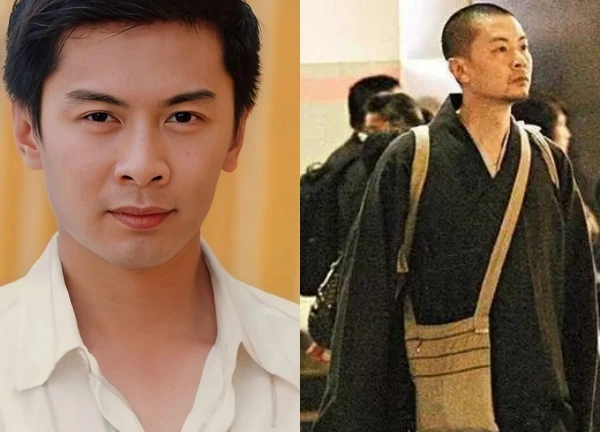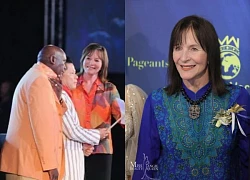Park Shi Hoo: The handsome man whose career was ruined because of a young girl, now his beauty is unbelievable

2 | 0 Discuss | Share
If Sherlock Holmes is famous for his excellent observation, interpretation, forensic science and logical reasoning abilities, Roxie Laybourne is admired for his ability to solve crimes with forensic skills through computers. feathers.
Roxie Laybourne (1910-2003), worked at the North Carolina State Museum of Natural History since 1932, at the National Museum's Fisheries Research Institute since 1944, and at the Ornithology and Mammal Research Institute by the United States Fish and Wildlife Service since 1946.
It wasn't until 1960 that Laybourne began performing his first bird dissection. Prior to that, she worked as a taxonomist for more than 15 years, preparing bird carcasses for study and display.
But a historic turning point happened, when the crash of Eastern Airlines Flight 375 took place on January 4, 1960. The Lockheed L-188 Electra carrying five crew members and 67 passengers made an unusual left turn and plunged into Winthrop Bay just six seconds after taking off from Boston's Logan International Airport. All 62 people died.
Crash investigators have found bits of black feathers inside three of the plane's four engines, and they want to know what kind of bird caused the massive plane to crash.
Roxie Laybourne's conclusion then surprised many. She said the feathers belonged to a bird weighing 0.08 kg, known as the European starling. They often fly in flocks, numbering hundreds to thousands of birds, swooping down in a coordinated fashion.
That was also the time when Roxie became completely enamored with this feathered forensics thing.
Today, the aviation industry has been able to identify the types of birds that often collide with aircraft and figure out how to effectively prevent them.
Airports today use dogs, optical illusions, and even lasers to keep birds away from hangars and runways. But at a time in the 1960s when the aviation industry was nascent, Laybourne's skill was something of a miracle.
She is affectionately known as the "feather woman" for her ability to determine almost exactly which bird was involved in an attack, based on microscopic marks.
She herself created the "Roxie method" - a procedure that can be replicated for many cases of forensic treatment for bird-induced plane crashes.
This method involved a four-step process and is still used today. Step one is to look at the entire physical evidence and look at everything from the moment the flock attacks to the collection of feathers.
Mercy Heaker, Laybourne's research assistant and student, describes this method: "If your nose is so close to a tree that it touches its bark, you won't be able to tell what kind of tree it is. You have to take a step back and see the big picture."
The second step of the method is "hair cleaning", which usually means washing the feathers in the same way one washes their hair in hot water and detergent and then blows it dry. Step 3 is to "look at the fine texture of the feather under the microscope", sometimes to look at the specific prongs inside a feather that can most accurately indicate the bird's species.
After reviewing the materials, incidents, microstructure of feathers and referencing the thousands of birds in the museum's collection, the fourth and final step is to make a phone call. That's when the anatomist has two or three abilities and must use his expertise and experience to be ready to name a particular species.
And identifying which types of birds may have collided with the plane provides fundamental data that experts can then use to manage airport habitats, create bird avoidance models, and help Engineers built more devices against feathered species approaching the airport.
And there are also cases where Laybourne has assisted in investigations beyond bird strikes. In a criminal case for the murder of his wife in Alaska, authorities speculated that the criminal left his wife's body at sea. Unfortunately, the body was never found, but the coat that appeared to have been worn by the wife was washed ashore.
The FBI contacted Laybourne, who later concluded from the researcher that the duck feathers inside the coat matched the feathers from the husband's car. Investigators say her findings helped convict the killer, along with eyewitness testimony that saw her husband load something into his car.
In a historical interview before his death in 2003 at the age of 92, Laybourne described his teaching philosophy as a moral obligation. “I have been given the opportunity to learn, and I feel that when you are given the opportunity to learn, for whatever reason, it is your responsibility to share it with others,†she said. . "So you can ask them to build on your knowledge and go beyond what you can do alone."
And the field of forensic investigation was continued by Carla Dove and Mercy Heacker, her students and associates. Both later incorporated DNA analysis into their work. However, in the later years of his career, Laybourne remained in favor of conducting DNA analysis in the first place, arguing that it was expensive and required special laboratories.
To make it more affordable, therefore, DNA analysis became the fifth step in the Roxie process. Sometimes, however, DNA analysis yields unexpected results, as in one crash case in 2008. At that time, a fighter jet flying north of Pensacola, Florida, hit something. at an altitude of 1,500m in the air.
After the wing was damaged and an emergency landing was required, an Air Force mechanic sampled a grease stain near the damage. Stains, made of blood, fat and microscopic bits of hair.
But when analyzed with DNA, the results showed that the tissue sample belonged to an animal that could never fly: a deer. Convinced that the results were misleading, the team sent back the sample three times, all of which yielded white-tailed deer DNA.
Dove and her team eventually had to go back to using the original Roxie method, specifically the third step - examining the microstructure of the feathers. They focused on a microscopic piece of feathers, the only thing that sticks to the jet.
"We made a micro slide and brought it to the microscope," says Dove. "We looked around and found some deer hair in it, but we also found a small band of hair, very suitable for a black vulture."
It is possible that the vulture ate the deer carcass before the jet collision, and the remains of the deer are likely DNA superior to the bird. For Dove, this case is a prime comparison of DNA analysis and the Roxie method, thereby realizing their effectiveness when used side-by-side.
This multi-pronged approach has helped solve thousands of subsequent crashes. In 2018 alone, the Feather Identification Laboratory identified nearly 11,000 birds hit by planes.
"She recognized the practical application that these collections can provide, which is a genius," commented Dove.
And yet, Laybourne's legacy today has moved her far beyond her role as a pioneering scientist. Her collection of thousands of birds at the Smithsonian Institution while alive became an applied science tool that changed aviation safety.

2 | 0 Discuss | Share

3 | 0 Discuss | Share

1 | 0 Discuss | Share

4 | 0 Discuss | Share

2 | 0 Discuss | Share

3 | 0 Discuss | Share

4 | 0 Discuss | Share

1 | 0 Discuss | Share

3 | 0 Discuss | Share

1 | 0 Discuss | Share

2 | 0 Discuss | Share

4 | 0 Discuss | Share










4 | 0 Discuss | Report